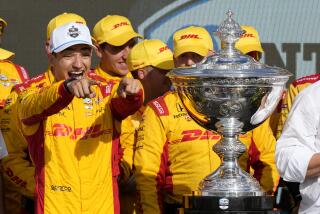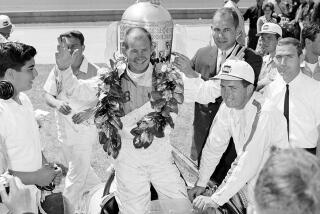He Took It Fron the Top
- Share via
You could tell right away this wasn’t a race car driver--at least, not an Indy race car driver.
First of all, there was that hair. You all know what an Indy driver looks like--he has a buzz cut. You can clearly see his ears and the back of his neck.
This guy had hair like America’s Sweetheart.
Then, there was the figure. Race drivers come in all sizes and silhouettes, but a prototype is a burly A.J. Foyt or a chunky Unser or two. This guy looked like a male model. Or a guy on his way to a tango parlor.
Then, there was the accent. Indy drivers usually have the twang of Texas, the syrup of the South or the drawl of the high plains in their speech. This guy had the throaty accent of Holland Dutch.
Then, there was the avocation. This guy collected art, not bubble gum cards. To be sure, they were automotively connected paintings, but they were of museum quality and he had his own gallery of them. In this country, race drivers collect calendars with Playboy centerfolds on them. If you asked them who Utrillo was, they’d frown and say, “Didn’t he win Indy back in ‘35?”
All in all, when Arie Luyendyk showed up at the Speedway in Indianapolis in 1985, the race crowd thought he had taken a wrong turn at Monte Carlo. He didn’t belong in the gritty, oil-slicked ovals of Indianapolis or Michigan, he should be on the sporty-car circuits dodging trees in Hockenheim or Zandvoort. This was not that silk-scarf, monocle, high society motor car sport for marquises and barons, this was the American brass-knuckle version. Go fast or go pit.
Arie Luyendyk loved it. He was as hotly competitive as any lead-shoe who ever came out of a Torrance garage. He reveled in going in the corners with the best of the full-throttle gang at The Brickyard. So much so that he was rookie of the year in his first crack at it. He finished seventh in a car that wasn’t necessarily that good. The important verb is, he finished. At Indy, that’s not something you see a lot of. The attrition rate is approximately that of a tank at Stalingrad.
Arie was more than another pretty face in a flameproof jumper. He was competition for the Unsers and Andrettis and Emmos and Sullivans. Victory eluded him, but he won a pole here (Portland), a second there, a top-five finish pretty much everywhere. He could hold a car together or push it to the limit. He had the obligatory crash at Pocono where the impact pulled his foot away from the ankle bone and healed painfully for months. A man is not a race driver with proper respect for the track till he has to be lifted out of his car a time or two.
But nothing prepared the racing Establishment for 1990 when Luyendyk was to win his first Indy car race. And it was not Phoenix or Road America or Laguna Seca. It was Broadway, the Met, the Palace. Starting at the top. The Indianapolis 500 itself. It was like making your first golf tournament win the Open, getting the Oscar for your first picture.
The automotive press went racing to the handouts to see who this Dutch treat was. They found he was the son of a Netherlands garage mechanic who had fallen in love with cars at an early age and who gypsied around Europe competing in a kind of training-wheels series called SuperVees.
When you win Indianapolis, you are joining an automotive elite. Only 54 drivers have won this event in its 76 years on the sporting scene.
This Flying Dutchman soon enjoyed celebrity status. David Letterman’s show, Regis Philbin’s show, books, magazines. People Magazine saluted him as one of the “50 Most Beautiful People In The World.” It was heady stuff, in a gallery with Elizabeth Taylor, Jodie Foster, Mel Gibson et al.
Usually, when you reach the top of your profession in anything, you can thenceforth write your own ticket. And, maybe Michael Jordan could.
But the auto racing business is like no other. The machines are so complicated and sophisticated that they require a $5-million investment to compete in the PPG Cup championship annually.
Race cars are simply automotive billboards, 230-m.p.h. traveling ads. But, all of a sudden, Arie was driving around in a racer without a single logo on it. It was as clean of decals--and sponsors--as the family station wagon. The team that won Indy was sold out from under him and he soon found himself not only under-sponsored but under-powered.
It happens all the time in car racing. The late Jimmy Clark, who may have been the greatest ever at two-sport race car driving, went from winner in 1965 and near-winner (disputed second) in 1966, to scrambling to get in a no-chance automotive burro in 1967 that not only started in the back of the sixth row but gave up the ghost after only 35 laps and finished 31st.
Arie Luyendyk had a similar struggle. He remained competitive in 1991, winning two races, but in 1992, he was down to competing in only two races (Indy and Michigan) and standing, helmet in hand, soliciting a chauffeur’s job.
It happens only in auto racing. Imagine Bill Shoemaker in his prime hawking the backstretch looking for a Derby mount? Picture Michael Jordan if he were a free agent having to send out resumes with job applications?
But the news is good this year. Target stores have come up with the sponsorship, Chip Ganassi with the experienced racing team and Arie Luyendyk’s jumpsuit has advertising everywhere but on the soles of his shoes. The Lola chassis of his car is awash with commercial tattoos.
This Dutch Master takes to the streets of Long Beach for the Toyota Grand Prix this weekend as a fully blooded Indy car driver, no one you want to see in your rearview mirror and no one whose rearview mirror you want to be in.
No one yells, “Get a haircut!” anymore. He belongs with this hairy-chested, get-out-of-my-way band of automotive brigands. If he keeps winning, given the superstitious nature of Gasoline Alley in general, look for the entire grid to show up looking like the cast of “A Chorus Line” any race now and give new meaning to the term “Let’s go Dutch.”
More to Read
Go beyond the scoreboard
Get the latest on L.A.'s teams in the daily Sports Report newsletter.
You may occasionally receive promotional content from the Los Angeles Times.










